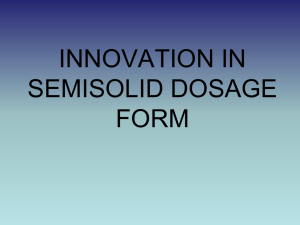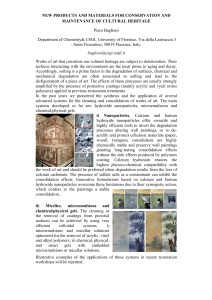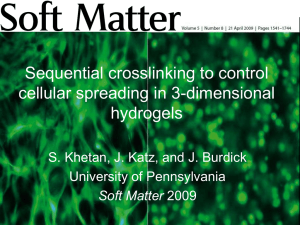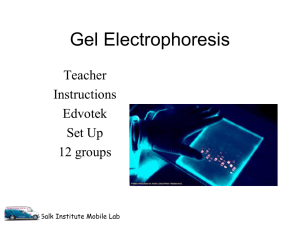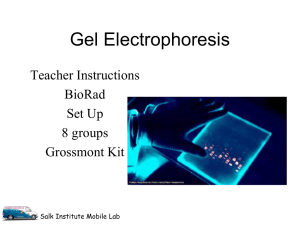Optimization of 3-D culture for human adipose
advertisement
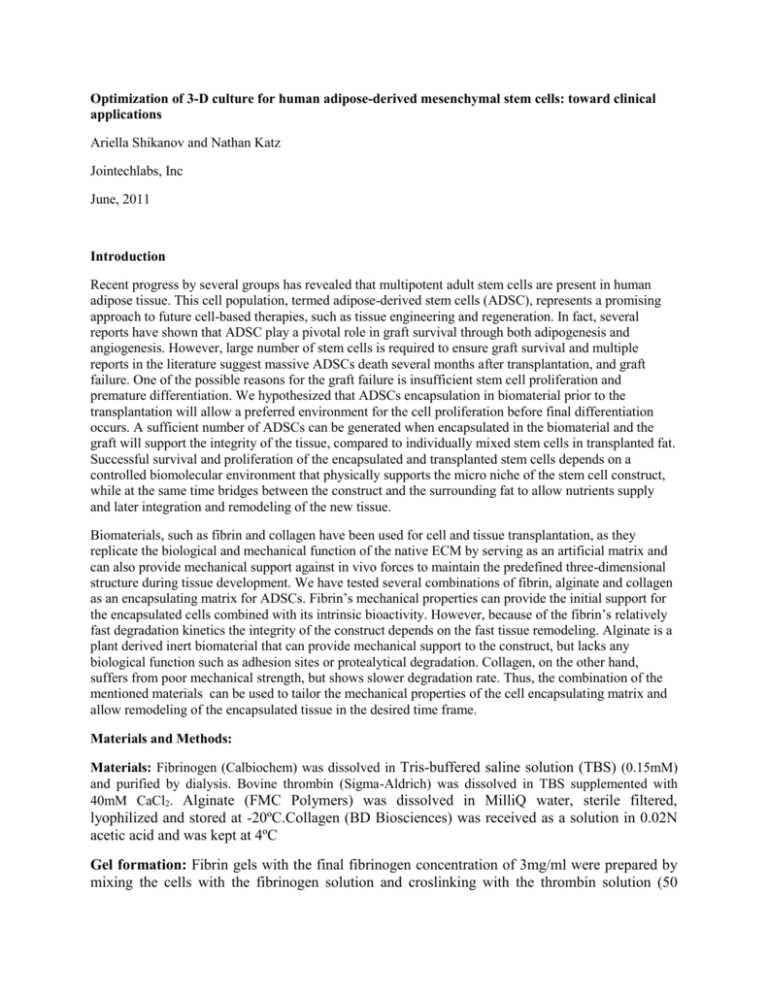
Optimization of 3-D culture for human adipose-derived mesenchymal stem cells: toward clinical applications Ariella Shikanov and Nathan Katz Jointechlabs, Inc June, 2011 Introduction Recent progress by several groups has revealed that multipotent adult stem cells are present in human adipose tissue. This cell population, termed adipose-derived stem cells (ADSC), represents a promising approach to future cell-based therapies, such as tissue engineering and regeneration. In fact, several reports have shown that ADSC play a pivotal role in graft survival through both adipogenesis and angiogenesis. However, large number of stem cells is required to ensure graft survival and multiple reports in the literature suggest massive ADSCs death several months after transplantation, and graft failure. One of the possible reasons for the graft failure is insufficient stem cell proliferation and premature differentiation. We hypothesized that ADSCs encapsulation in biomaterial prior to the transplantation will allow a preferred environment for the cell proliferation before final differentiation occurs. A sufficient number of ADSCs can be generated when encapsulated in the biomaterial and the graft will support the integrity of the tissue, compared to individually mixed stem cells in transplanted fat. Successful survival and proliferation of the encapsulated and transplanted stem cells depends on a controlled biomolecular environment that physically supports the micro niche of the stem cell construct, while at the same time bridges between the construct and the surrounding fat to allow nutrients supply and later integration and remodeling of the new tissue. Biomaterials, such as fibrin and collagen have been used for cell and tissue transplantation, as they replicate the biological and mechanical function of the native ECM by serving as an artificial matrix and can also provide mechanical support against in vivo forces to maintain the predefined three-dimensional structure during tissue development. We have tested several combinations of fibrin, alginate and collagen as an encapsulating matrix for ADSCs. Fibrin’s mechanical properties can provide the initial support for the encapsulated cells combined with its intrinsic bioactivity. However, because of the fibrin’s relatively fast degradation kinetics the integrity of the construct depends on the fast tissue remodeling. Alginate is a plant derived inert biomaterial that can provide mechanical support to the construct, but lacks any biological function such as adhesion sites or protealytical degradation. Collagen, on the other hand, suffers from poor mechanical strength, but shows slower degradation rate. Thus, the combination of the mentioned materials can be used to tailor the mechanical properties of the cell encapsulating matrix and allow remodeling of the encapsulated tissue in the desired time frame. Materials and Methods: Materials: Fibrinogen (Calbiochem) was dissolved in Tris-buffered saline solution (TBS) (0.15mM) and purified by dialysis. Bovine thrombin (Sigma-Aldrich) was dissolved in TBS supplemented with 40mM CaCl2. Alginate (FMC Polymers) was dissolved in MilliQ water, sterile filtered, lyophilized and stored at -20ºC.Collagen (BD Biosciences) was received as a solution in 0.02N acetic acid and was kept at 4ºC Gel formation: Fibrin gels with the final fibrinogen concentration of 3mg/ml were prepared by mixing the cells with the fibrinogen solution and croslinking with the thrombin solution (50 mg/ml). Fibrin-alginate (FA) gels were prepared by mixing the cells with the fibrinogen and alginate solution and crosslinking with the thrombin. The final concentration of fibrinogen and alginate in FA gels was 3mg/ml and 0.125% w/v. Fibrin-collagen (FC) and fibrin- collagenalginate (FCA) gels were prepared according to the manufacturer instructions. The final concentration of fibrinogen, collagen and alginate in FC and FCA gels was 3mg/ml, 2mg/ml and 0.125% w/v, respectively. The gels were prepared as stable gels in 48-well plate at a volume of 200 µl, or as floating gels in 96-well plates at a volume of 50 µl. Cells were encapsulated at 100,000, 250,000, 2x106 and 20x106 cell/ml concentration. Cell culture and gel degradation: The gels were culture in 10% supplemented DMEM for 7, 14 and 21 days. The media was changed in the wells every 2-3 days. At each time point the gels were washed with PBS to remove media and then were incubated for 1 hour in protease cocktail, containing 0.4% Collagenase II, 0.4% Collagenase IV, and alginate lyase for the gels containing alginate. The gels were physically sheared every 7-10 minutes till the gels fully degraded and appeared as a single cell suspension. The cells were washed, counted and fixed. Results and Discussion: 1. Effect of the cell concentration in the gel on cell proliferation Cells were encapsulated in fibrin and fibrin-alginate gels at different concentrations to determine the optimal cell concentration to support maximum proliferation. Cells were encapsulated in fibrin gels at 100,000 and 2x106 cells/ml, while in FA gels cells were encapsulated at 100,000, 2x106 and 20x106 cells/ml. The gels were degraded after 7 and 14 days of the culture and the cells number as the percentage increase was assessed (Table 1). Table 1: The increase in cell concentration in the gels during in vitro culture as a percentage on the initial load (100%). Fibrin (3mg/ml) 100,000 cells/ml Fibrin-alginate (FA) (3mg/ml, 0.125%) 2x106 cells/ml 100,000 cells/ml 2x106 cells/ml 20x106 cells/ml D7 D14 D7 D14 D7 D14 D7 D14 D7 D14 333% 1408% 40% 117% 283% 433% 28% 11% 22% 20% Fibrin gels supported cells’ proliferation when the initial cell concentration was 100,000 cells/ml, as was demonstrated with 333% increase in cell number after 7 days of culture and 1408% increase after 14 days. The cells’ viability was greater than 85%. However, when cells were encapsulated at 20 times greater concentration (2x106 cells/ml) fibrin gel did not support proliferation and the cell number decreased after 7 days of culture and was similar to the initial cell concentration after 14 days. Similar results were obtained when the cells were encapsulated and cultured in FA gels. At lower cell load of 100,000 cells/ml increase of 283% and 433% after 7 and 14 days of culture was observed, while no proliferation was achieved in greater cell loads of 2x106 and 20x106 cells/ml. We concluded that an important balance between cell load, matrix degradation and new ECM deposition should be kept in order to support sufficient cell proliferation and this balance was achieved in fibrin and FA gels with 3mg/ml fibrinogen and 100,000 cell/ml. 2. Protection effect of the hydrogels during freeze/thaw process Fibrin and FA gels with encapsulated cells (100,000 cells/ml) were slow frozen and stored in liquid nitrogen at least 24 hours. After thawing the gels were cultured and the cell proliferation was assessed (Table 2). Table 2: Cell proliferation after freeze/thaw process and culture for 7 days. Fibrin (3mg/ml) Fibrin-alginate (FA) (3mg/ml, 0.125%) 100,000 cells/ml 100,000 cells/ml D7: 400% D7: 400% Cell concentration during 7 days of culture following freeze/thaw process increased 400% comparing to the initial cell load. Morphological examination of the gels revealed intact gels with encapsulated cells that maintained the 3-dimentional structure during the culture period. 3. Collagen did not support cell proliferation Collagen is a native component of the ECM, but with slower degradation kinetics compared to fibrin and similar bioactivity. We hypothesized that collagen addition to the fibrin gels will slow the gel degradation and help overcome the alginate inertness in FA gels. Table 3: Cell proliferation in fibrin-collagen (FC) and Fibrin-collagen -alginate (FCA) gels during 14 days of culture. Fibrin –collagen (FC) (3mg/ml, 2 mg/ml) Fibrin-collagen -alginate (FCA) (3mg/ml, 2 mg/ml, 0.125%) 100,000 cells/ml 100,000 cells/ml D7:100% D14:50% D7:100% D14:90% However, as shown in Table 3, collagen addition to the gel did not result in cell support and improved proliferation. The cells’ number remained similar to the initial cell load after 7 days of culture in both condition, and decreased to 50% and 90% in FC and FCA conditions after 14 days of culture. In summary, we have demonstrated that fibrin and fibrin-alginate gels were able to support 3-dimentional cell culture while promoting cell proliferation. The initial cell load had a crucial effect on cell proliferation, while lower cell load resulted in 10 time’s greater cell concentration after 2 weeks of culture, and higher cell load resulted in hydrogel collapse and cell death. We have also shown that the hydrogels protected the cells during freeze/thaw process and were ready to culture immediately after the thawing process. This may serve an important tool for clinical application of the matrix.

